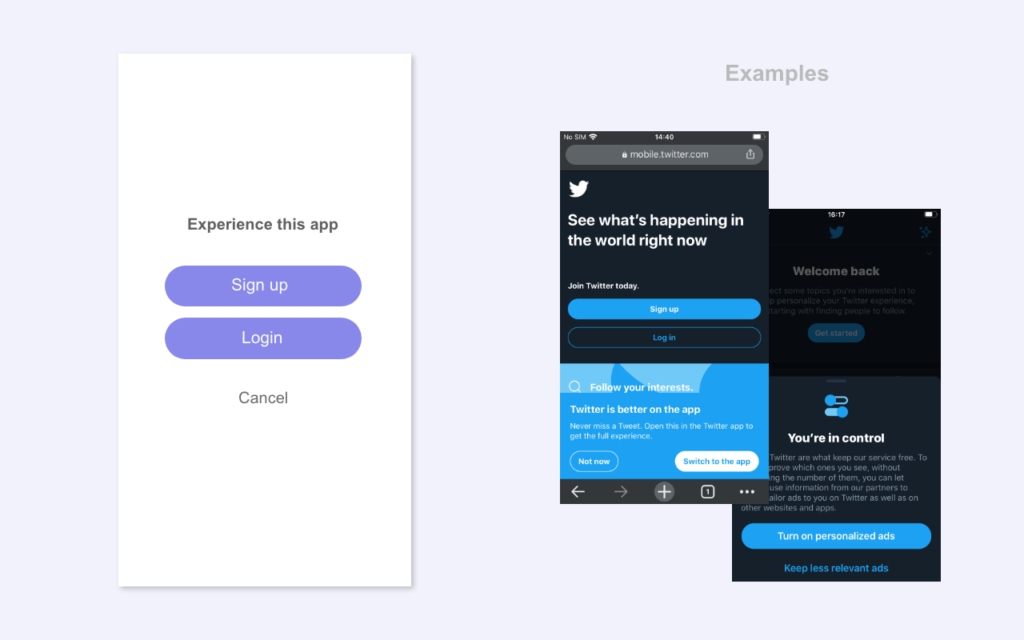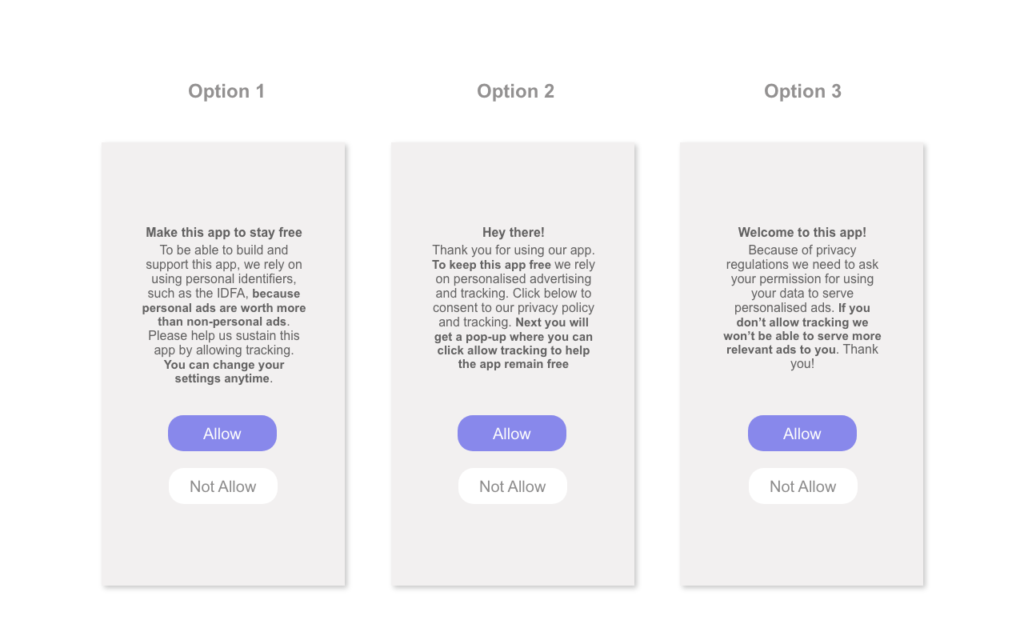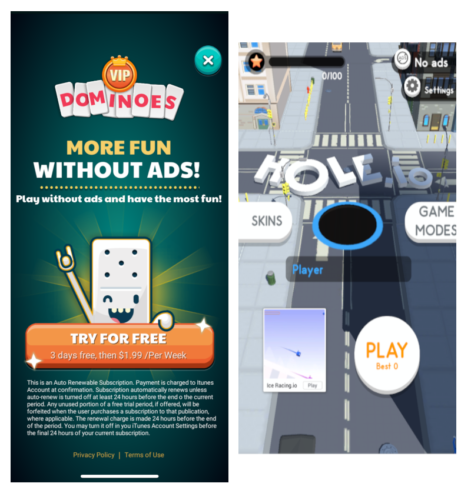Update as of Feb 8, 2021: Apple’s AppTrackingTransparency (ATT) framework is expected to go live and be enforced in the upcoming public release of iOS 14 in March.
Improve opt-in rates in iOS 14
This autumn, what is probably to be mid to end of September, Apple is launching its iOS 14 update with new privacy regulations shaking up the mobile advertising ecosystem. There have been many discussions and articles written about how this will affect publishers, advertisers and other players in the industry and we previously discussed how the forecasted ‘apocalypse’ is actually a very important milestone for privacy-first advertising. But until we get there, we want to address what’s probably more relevant in the short term, especially considering the tight timeline, which is to improve opt-in rates for app developers – advertisers and publishers alike.
Verve has been researching the best practices from top publishers across app verticals. From the results of the research, we’ve put together an interactive user journey for iOS 14, which you can try at the end of the article.
The journey will take you through the user funnel as you go from downloads/updates, to first steps, as well as engagements later down the funnel. How many users can you expect at each stop? Let’s begin.

Disclaimer: It is yet unknown whether Apple will require developers to only prompt the opt-in pop-up before the SSO (for third party SSOs such as Google and Facebook) or before the email sign in as well. From the documentation it seems that Apple Sign In doesn’t require the AppTransparency Framework or IDFA opt-in. We are following the progress closely and will share updates once Apple clarifies its position.
0% of users: Soft pop-up
From the above opt-in flow diagram on the user journey, it is when the user downloads the app that the journey begins, at the bottom of the chart. By default, the Identifier for Advertisers (IDFAs) are zeroed out if requested and due to this, 0% of the users can be identified.
For publishers to adjust to the privacy changes with iOS 14 it is essential to optimize opt-ins and IDFA gathering. What is changing with this update is that developers will now have to actively ask users for their consent to track them and use their IDFA, which is otherwise by default not allowed. This will now be similar to what we have seen from location-tracking in many apps. When the iOS 14 update goes live, it will be crucial to optimize the opt-in flow to collect users’ IDFA, especially during the initial period after the iOS 14 release as the whole industry will be adapting. We can look and learn from the web where, for instance, Criteo managed to sustain their revenues despite sweeping changes in Apple’s privacy update. Changes do also bring opportunities, and as Criteo adapted to Apple’s update, they also saw demand in new kinds of products.
Before we continue we want to make a clear distinction between consent (legal framework under GDPR or CCPA) and opt-in (platform-specific requirement – as is the case with iOS 14). We will mainly focus on the opt-in part with certain comments regarding GDPR.
The key point here is to make the user understand why you need to collect their opt-in and be able to track. Emphasize the value exchange, e.g. you can mention that, without tracking, the user will get less relevant ads delivered to them. Some publishers from our research have even gone one step further and are mentioning that by allowing personalized ads, it is easier for the app to remain free.

10% of users: Apple opt-in
In this journey, we will take learnings from the past, from the evolution of CMPs and consent flows (in the GDPR sense) to help guide our approach, improve our results and accelerate our learning timeline to increase IDFA opt-in rates to achieve similar results. Thereby there are several points to take into account:
1. The message
Developers can align the communication style to the type of app to target the audiences it serves (whether it’s a hyper-casual game, a news app, or a social app). If successfully communicated, this is the first step to long-term engagement and commitment from the user. As mentioned above, let the user understand the whats and whys – make the value exchange clear.
We tested several options of the pop-up text internally across our teams to see which one would be most appealing. Our teams could choose between three options with different value propositions. Please see the three options and the value propositions marked in bold, below.

The poll had a clear winner, which was option 2, which we also optimized based on additional suggestions from the team:

2. Timing
Not only is the message important, but timing is just as important in deciding the outcome. As the user proceeds through the funnel, experiencing and engaging with the app’s content, the developer can choose at which point to prompt the soft pop-up. In addition, developers can choose when to prompt the Apple opt-in pop-up which should ideally be prompted directly afterwards, asking for consent.
Putting the pop-up after a positive event, such as when a user just finishes a level, could be a good option to achieve positive results. We have also seen publishers from our research who prompt the pop-up at the very beginning of a session. For instance, after clicking the play button the user is shown the pop-up, and it could be another good option since users are very keen to play at this point in the user journey. Below is an example of timing the pop-up just after hitting the play button.
 From left to right – clicking play and then prompting the pop-up
From left to right – clicking play and then prompting the pop-up
Another idea is to segment users between engaged and less engaged users (with the help of CRM/analytics tools), and choose the right moment based on predicted behavior.

Once the user gives their consent (yes in the chart above) to the soft pop-up, it is now time for the developer to prompt the Apple system opt-in pop-up by making a request to the AppTransparency Framework, which will make the IDFA available. This opt-in pop-up differs from the soft consent one, addressed above, in the core function that it is an Apple-specific software pop-up, which is new with iOS 14. Whereas the soft pop-up is fully made by the developer, in Apple’s system opt-in pop-up you can only customize the text after the pre-filled headline. In our beta tests there was no limit to the length of the text, but it must fit the pop-up window by Apple.
You can and should optimize the text to target your audience, as you can see in an example we made below, but the core value lies in the soft pop-up prompted before this opt-in pop-up. Still we recommend A/B testing both;
- The soft pop-up
- The system opt-in

After the Apple opt-in pop-up the developer can choose if he wants to send the user directly to the full content or offer third-party SSO (Single Sign-On) such as Google or Facebook logins. Apple requires developers to prompt the system opt-in before using features such as signing in with a third-party SSO. Hence for the developers who want to offer SSO to their users, the right time to offer this option is after the opt-in. Whether this will also be required for (first-party) email login is yet unknown. Do note that this could pose significant challenges to all third-party SSO login flows, including Facebook and Google O&O apps as well as third-party apps using their solutions.
20% of users: Sign up
A recent report by Adikteev has shown interesting results: almost 50% of users who were shown a custom soft pop-up first accepted the value exchange/reacted positively, which is significantly higher than the predicted 10-20% in various discussions previously. If the user consents to both, the path is clear towards accessing the full app content.

However, for the remaining percentage of users who do not opt in for IDFA tracking, there are a few options to consider. We are now in the middle of the user funnel in the chart and the user has denied consent to both the soft pop-up and the opt-in pop-up. The next step is to suggest a login option, since login data can serve as an alternative identifier to the IDFA.
As mentioned above, the value exchange should be properly described. It could be:
- Access to more features/content
- Cross-platform syncs (with web or other devices)
- Saving progress between devices (for example, if getting a new phone)
- Ability to play with friends
- Or share or store results/scores
If the user agrees to login, they often also agree to the terms as seen in our research – and after the login, the developer can choose to either additionally prompt the Apple opt-in pop-up if needed – or just use the login data.

50% of users: Paywall

We’ve now arrived at the last stop of the funnel as seen above. If the user does not choose to log in there is an option to support the app via an in-app payment by:
- Either a one time payment
- Or a subscription (if the app continues to add new content)
Some apps have less than 10 percent of paid users, and others only work via subscriptions or in-app purchases (IAPs) with no free versions. From our research we could find only a handful of apps that leverage this option (less than 20%) by either:
- Adding a no-ads button on the homescreen or
- Showing a timed pop-up with this option during gameplay/user session
Please see examples of this below and in the interactive user journey.
 Examples from different apps with paid no-ads options
Examples from different apps with paid no-ads options

How Apple will react to these changes remains to be seen but there is positive precedent in terms of legal consent under GDPR, with the CNIL (the French GDPR authority) deciding in favor of this approach as long as the user has multiple other options to choose from. For instance, the choice between tracking, logging in for free or a paywall is considered a balanced approach to privacy and conform under GDPR. This is also how we have structured our consent flow and user journey below.
Whatever option the user chooses, it is important for the publishers to have an open dialog with the users, by being transparent and honest, offering several options and emphasizing how each particular option supports the app and its creators. By adopting the right techniques, we can reverse some of the negative effects iOS 14 will have on Ad LTV and increase user value by coupling it with consumer choice and higher added value through logins (for instance cloud saves, the ability to play on multiple platforms and the ability to play with friends).
Optimizing the user journey to improve opt-in rates
The good thing is, the user only goes through this funnel once and hopefully by the end of it, more than half of the users would have understood the value exchange, the options available, and would either opt-in, log in or choose the premium option.
Developers will have a different amount of users at different stages and it will become increasingly important to optimize each step of the user journey to ensure the value of the users adapting to the upcoming changes. It starts with iOS but Android is expected to follow suit soon and, in general, developers should take proactive steps to understand their user base better. This includes their preferences and developers should then leverage that understanding for better advertising to create a stronger relationship with their users.
The time to act is yesterday
What we can learn from the web with the rise of ad blockers and then GDPR, is that the time to act is yesterday. Publishers should start implementing and testing variations in order to speed up the process of learning, planning, designing and monitoring what works best for their users.
The second action – which is equally as important – is sharing the findings and engaging in conversations. The whole industry will benefit, and there is little to gain from keeping the results internal – except if you are a huge publisher that has/is an ecosystem in itself, but even then it’s arguable.
Firstly, because the apps are easier to download by everyone – so nothing is really hidden – and secondly, because this dialog is in the end between the publisher community and the consumer. Additionally, one word of caution – even if advertisers manage to get 50% of the 70% non limit ad tracking (LAT) users, and publishers get another 50% of their 70%, the overlap between the two will probably not be more than a few percentage points higher. That’s why it’s important that the whole community – developers and users alike – engage in this undertaking.
We have made an interactive user journey where you can go through the different steps of the funnel. Each slide has some of the best examples from our research, with suggestions of how to apply these learnings across verticals. We hope this will help publishers as well as advertisers to prepare for the upcoming privacy changes and to optimize for more high-value users. Try out the user journey flow below.
If you have any questions or concerns regarding iOS 14 and improving opt-in rates, please contact us or your Account Manager directly and we’ll help to assist you further.








